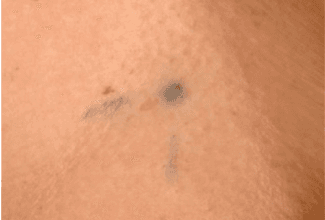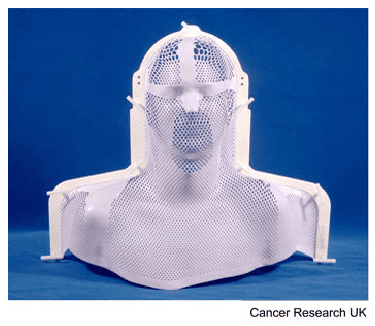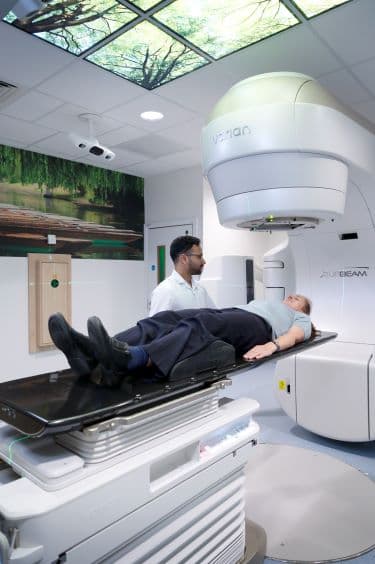Types of external radiotherapy
Intensity modulated radiotherapy (IMRT) is a type of conformal radiotherapy. Conformal radiotherapy shapes the radiation beams to closely fit the area of cancer.
You can have IMRT on a standard radiotherapy machine, called a linear accelerator (LINAC).
The LINAC has a device called a multileaf collimator. The multileaf collimator is made up of thin leaves of lead which can move independently.
They can form shapes that fit precisely around the treatment area. The lead leaves can move while the machine moves around the patient. This shapes the beam of radiation to the tumour.
This means that the tumour receives a very high dose and normal healthy cells nearby receive a much lower dose.
Each radiotherapy beam is divided into many small beamlets. This can vary the intensity of radiation. It can give different doses of radiation across the tumour.
IMRT can be very helpful in areas such as the head and neck, for example to avoid the spinal cord or salivary glands.
There are several steps involved in planning IMRT.
You begin with a CT scan at the radiotherapy department. You may also have MRI scans or PET scans. The information from these scans feeds directly into the radiotherapy planning computer.
The treatment team carefully plans the treatment using the scan images. They use advanced computerised calculations. This finds the dose strength pattern that best matches the tumour shape.
The planning may take longer for IMRT compared to other types of radiotherapy.
The radiographers might make marks on your skin that act as reference points. This is to make sure every treatment session is accurate.

If you have radiotherapy to your head or neck, you may need to wear a radiotherapy mask during your treatment. This is also called a shell or mould.
Most types of masks are made of a mesh material with lots of small holes. You can have a mould for other parts of the body, such as the breast or limbs.
The mould or mask keeps the treatment area completely still. This is so your treatment will be as accurate as possible.

You usually have to wait a few days or up to 2 weeks for your treatment plan to be ready.
You then get an appointment for your first session of radiotherapy.
To have the treatment you lie on a radiotherapy couch. Your radiographers help you to get into the right position and put on any moulds that you may need.
You might have the treatment from a machine called a LINAC. Or another type of radiotherapy machine, for example a TomoTherapy machine. TomoTherapy is a CT scanner combined with IMRT.

Once you are in the right position your radiographers leave you alone in the room. This is so they are not exposed to the radiation.
They will often take x-rays before you have treatment. This is to ensure that you're in the correct position and is called image guided radiotherapy (IGRT).
Your radiographers watch you carefully either through a window or on a closed circuit television screen (CCTV). They can talk to you through an intercom. They may ask you to hold your breath or take shallow breaths during the treatment.
You can't feel radiotherapy when you actually have the treatment. It doesn’t hurt. It may take between 15 and 30 minutes or more.
VMAT is a type of IMRT technique. VMAT stands for Volumetric Arc Therapy and is also called Rapid Arc.
VMAT is different to normal IMRT. The radiotherapy machine rotates around the patient during a radiotherapy beam. This is in an arc shape.
The machine continuously reshapes and changes the intensity of the radiation beam as it moves around the body.
Giving the radiotherapy in this way:
makes it very accurate
shortens the treatment time
uses a lower overall dose of radiation
The treatment usually takes about 10 minutes.
TomoTherapy is a type of IMRT.
For this treatment you lie on the radiotherapy couch which moves through a donut-shaped machine. The radiation source in the machine rotates around you in a spiral pattern. It is also sometimes called helical tomotherapy.
IMRT is a standard form of treatment for some types of cancer, including breast and prostate.
Some trials are looking at improving the way you have radiotherapy treatment.
With IMRT there is less normal tissue in the treatment area. So the risk of side effects is lower, but you might still experience some side effects.
As with any external beam radiotherapy, the side effects only affect the part of the body that the radiotherapy treatment is aimed at.
Last reviewed: 06 Nov 2023
Next review due: 06 Nov 2026
External radiotherapy uses radiotherapy machines to aim radiation beams at a cancer. This destroys the cancer cells. There are different types of external radiotherapy.
Conformal radiotherapy shapes the radiation beams to closely fit the area of the cancer. It is also called 3D conformal radiotherapy or 3DCRT. It is a very common type of radiotherapy.
The radiotherapy team will create a treatment plan for you. This involves using scans to work out exactly where to treat and how many radiation beams you need.
Your radiotherapy team carefully work out how much radiation you need to treat the cancer and exactly where you need it.
Radiotherapy can cause different side effects depending on which part of the body is being treated. Find out what these side effects are and how they affect you during and after treatment.
Find out about cancer treatment with radiotherapy, including external radiotherapy, internal radiotherapy, side effects, radiotherapy for symptoms and follow up after treatment.

About Cancer generously supported by Dangoor Education since 2010. Learn more about Dangoor Education
What to ask your doctor about clinical trials.
Meet and chat to other cancer people affected by cancer.
Questions about cancer? Call freephone 0808 800 40 40 from 9 to 5 - Monday to Friday. Alternatively, you can email us.